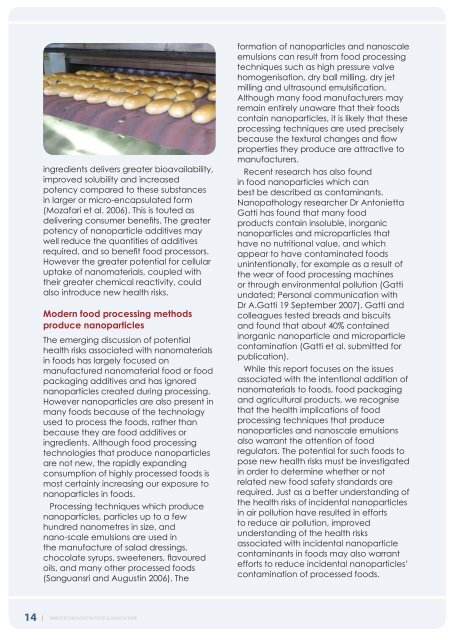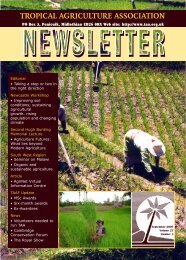Nanotechnology in Food & Agriculture
Nanotechnology in Food & Agriculture
Nanotechnology in Food & Agriculture
You also want an ePaper? Increase the reach of your titles
YUMPU automatically turns print PDFs into web optimized ePapers that Google loves.
<strong>in</strong>gredients delivers greater bioavailability,improved solubility and <strong>in</strong>creasedpotency compared to these substances<strong>in</strong> larger or micro-encapsulated form(Mozafari et al. 2006). This is touted asdeliver<strong>in</strong>g consumer benefits. The greaterpotency of nanoparticle additives maywell reduce the quantities of additivesrequired, and so benefit food processors.However the greater potential for cellularuptake of nanomaterials, coupled withtheir greater chemical reactivity, couldalso <strong>in</strong>troduce new health risks.Modern food process<strong>in</strong>g methodsproduce nanoparticlesThe emerg<strong>in</strong>g discussion of potentialhealth risks associated with nanomaterials<strong>in</strong> foods has largely focused onmanufactured nanomaterial food or foodpackag<strong>in</strong>g additives and has ignorednanoparticles created dur<strong>in</strong>g process<strong>in</strong>g.However nanoparticles are also present <strong>in</strong>many foods because of the technologyused to process the foods, rather thanbecause they are food additives or<strong>in</strong>gredients. Although food process<strong>in</strong>gtechnologies that produce nanoparticlesare not new, the rapidly expand<strong>in</strong>gconsumption of highly processed foods ismost certa<strong>in</strong>ly <strong>in</strong>creas<strong>in</strong>g our exposure tonanoparticles <strong>in</strong> foods.Process<strong>in</strong>g techniques which producenanoparticles, particles up to a fewhundred nanometres <strong>in</strong> size, andnano-scale emulsions are used <strong>in</strong>the manufacture of salad dress<strong>in</strong>gs,chocolate syrups, sweeteners, flavouredoils, and many other processed foods(Sanguansri and August<strong>in</strong> 2006). Theformation of nanoparticles and nanoscaleemulsions can result from food process<strong>in</strong>gtechniques such as high pressure valvehomogenisation, dry ball mill<strong>in</strong>g, dry jetmill<strong>in</strong>g and ultrasound emulsification.Although many food manufacturers mayrema<strong>in</strong> entirely unaware that their foodsconta<strong>in</strong> nanoparticles, it is likely that theseprocess<strong>in</strong>g techniques are used preciselybecause the textural changes and flowproperties they produce are attractive tomanufacturers.Recent research has also found<strong>in</strong> food nanoparticles which canbest be described as contam<strong>in</strong>ants.Nanopathology researcher Dr AntoniettaGatti has found that many foodproducts conta<strong>in</strong> <strong>in</strong>soluble, <strong>in</strong>organicnanoparticles and microparticles thathave no nutritional value, and whichappear to have contam<strong>in</strong>ated foodsun<strong>in</strong>tentionally, for example as a result ofthe wear of food process<strong>in</strong>g mach<strong>in</strong>esor through environmental pollution (Gattiundated; Personal communication withDr A.Gatti 19 September 2007). Gatti andcolleagues tested breads and biscuitsand found that about 40% conta<strong>in</strong>ed<strong>in</strong>organic nanoparticle and microparticlecontam<strong>in</strong>ation (Gatti et al. submitted forpublication).While this report focuses on the issuesassociated with the <strong>in</strong>tentional addition ofnanomaterials to foods, food packag<strong>in</strong>gand agricultural products, we recognisethat the health implications of foodprocess<strong>in</strong>g techniques that producenanoparticles and nanoscale emulsionsalso warrant the attention of foodregulators. The potential for such foods topose new health risks must be <strong>in</strong>vestigated<strong>in</strong> order to determ<strong>in</strong>e whether or notrelated new food safety standards arerequired. Just as a better understand<strong>in</strong>g ofthe health risks of <strong>in</strong>cidental nanoparticles<strong>in</strong> air pollution have resulted <strong>in</strong> effortsto reduce air pollution, improvedunderstand<strong>in</strong>g of the health risksassociated with <strong>in</strong>cidental nanoparticlecontam<strong>in</strong>ants <strong>in</strong> foods may also warrantefforts to reduce <strong>in</strong>cidental nanoparticles’contam<strong>in</strong>ation of processed foods.14| NANOTECHNOLOGY IN FOOD & AGRICULTURE



